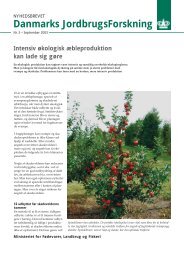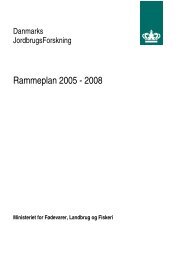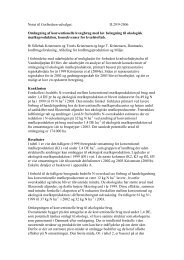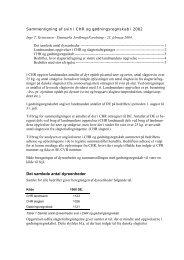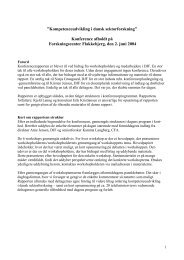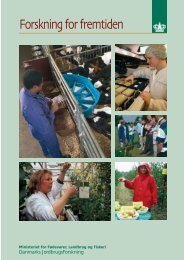Reproduction performances and conditions of group-housed non ...
Reproduction performances and conditions of group-housed non ...
Reproduction performances and conditions of group-housed non ...
You also want an ePaper? Increase the reach of your titles
YUMPU automatically turns print PDFs into web optimized ePapers that Google loves.
- Paper I -<br />
a consequence <strong>of</strong> stress. However, no matter what may have caused the lower weight gain,<br />
the result would be less energy substrates available for the physiological processes related<br />
to reproduction. In the study by Brouns & Edwards (1994), the weight gain throughout<br />
gestation in the low ranking sows was only 60% (28.3 vs. 46.6 kg) <strong>and</strong> 50% (22.4 vs. 44.9<br />
kg) <strong>of</strong> the weight gain <strong>of</strong> the high ranking sows, respectively in two different experimental<br />
pens. The total gain <strong>of</strong> 44.9 kg <strong>and</strong> 22.4 kg during an entire gestation corresponds with approximately<br />
0.390 kg <strong>and</strong> 0.195 kg daily gain, respectively. The <strong>group</strong>s consisted <strong>of</strong> multiparaous<br />
sows <strong>and</strong> the ranking order was significantly correlated with initial live weight <strong>of</strong><br />
the sows (Brouns & Edwards, 1994). According to Danielsen (personal communication,<br />
2003), one kg <strong>of</strong> gain in gestation requires 14 MJ ME, for which reason 0.390 <strong>and</strong> 0.195 kg<br />
<strong>of</strong> gain would require 6 <strong>and</strong> 3 MJ ME, respectively. Assuming that high ranking sows<br />
weighted about 260 kg <strong>and</strong> low ranking sows 200 kg, the daily energy requirement for<br />
maintenance for high <strong>and</strong> low ranking sows would be approximately 27 MJ ME <strong>and</strong> 23 MJ<br />
ME, respectively (Just et al., 1983; Theil et al., 2002; Danielsen, personal communication<br />
2003). Estimated energy intake for low ranking sows would therefore be approximately 80<br />
% <strong>of</strong> the energy intake <strong>of</strong> the high ranking sows (26 <strong>and</strong> 33 MJ ME, respectively).<br />
In commercial practice, the difference between high <strong>and</strong> low ranking sows’ feed intake<br />
during pregnancy may, under some circumstances, be higher than indicated in the studies<br />
by Andersen et al. (1999) <strong>and</strong> Brouns & Edwards (1994). In these studies, the <strong>group</strong> size<br />
was six <strong>and</strong> 12 sows, respectively, whereas in commercial sow herds, floor feeding is also<br />
practiced in larger <strong>group</strong>s. If the feed is provided on a small area, it is likely that the more<br />
sows in the <strong>group</strong>, the higher the risk that the low ranked sows are kept away from the feeding<br />
place. Experiences from practical husb<strong>and</strong>ry indicate that a huge variation in weight<br />
between sows causes more aggressions <strong>and</strong> displacements at feeding compared to more<br />
uniform <strong>group</strong>s (Olsson & Svendsen, 1997). Therefore, the magnitude <strong>of</strong> the variation in<br />
energy intake between <strong>group</strong> <strong>housed</strong> sows will probably not only depend upon feeding procedure<br />
but also on <strong>group</strong> size <strong>and</strong> <strong>group</strong> composition <strong>and</strong> then vary considerably between<br />
herds but also within herds between farrowing batches.<br />
It is generally recommended to feed pregnant sows in the range <strong>of</strong> 25-35 MJ ME day -1<br />
(NRC, 1998; The National Committee for Pig Production, 2003b). If sows for instance are<br />
provided with 30 MJ ME day -1 , <strong>and</strong> assuming that the low ranking sows only eat approximately<br />
50-80% <strong>of</strong> the portion that high ranking sows as indicated in the studies by<br />
Andersen et al. (1999) <strong>and</strong> Brouns & Edwards (1994), this means that high ranking sows<br />
would consume 33-40 MJ ME day -1 <strong>and</strong> low ranking sows 20-26 MJ ME day -1 in average.<br />
In gilts, an energy intake <strong>of</strong> 33-40 MJ ME day -1 could have a negative influence on litter<br />
size if it occurs the first three days after mating. An energy intake <strong>of</strong> 20-26 MJ ME day -1<br />
40




